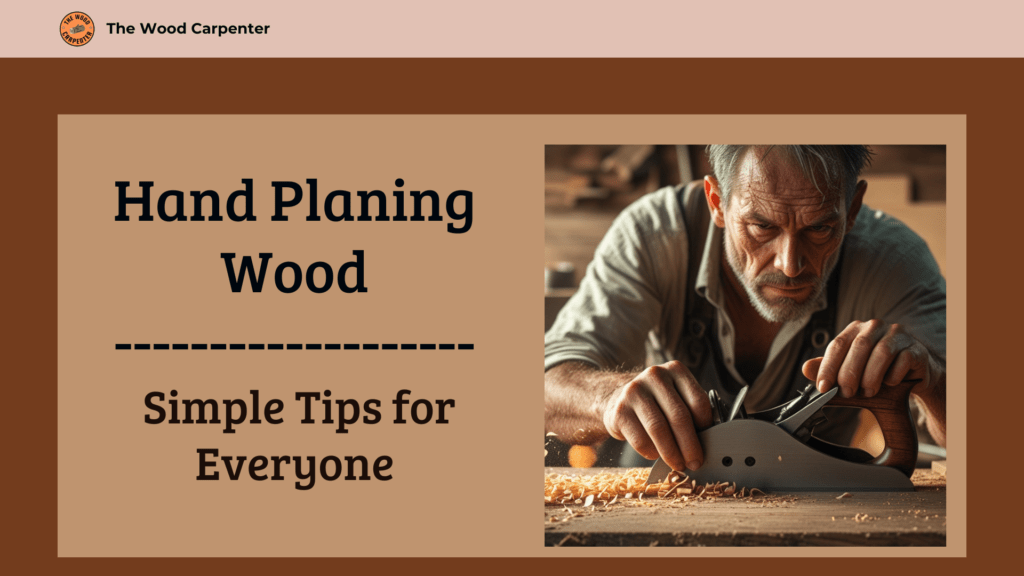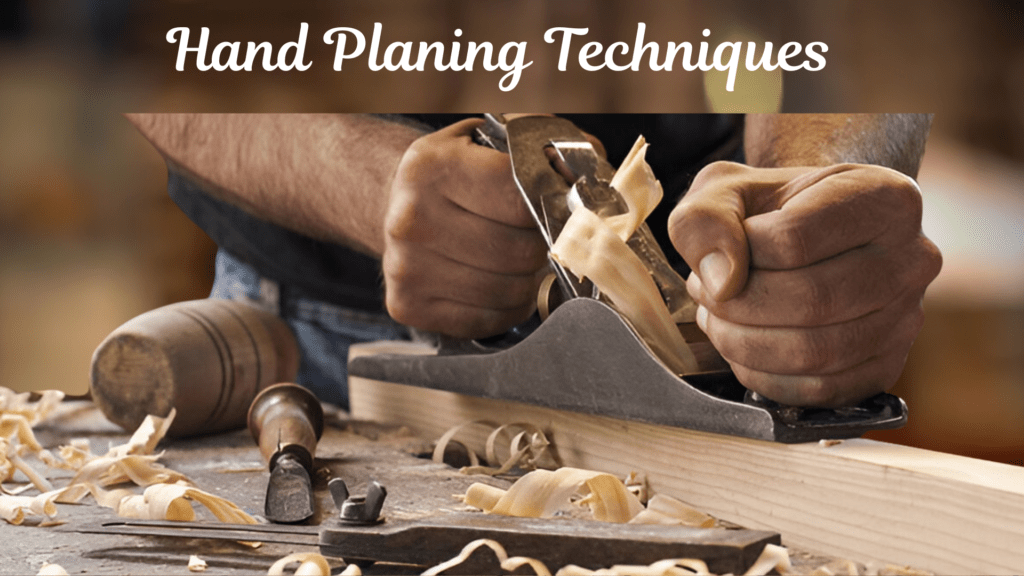
Hand planing wood is an essential skill for smoothing and shaping wood. While power tools can do the job quickly, using a hand plane brings a unique sense of satisfaction.
Whether you’re a beginner or have years of woodworking experience, learning hand planing techniques will help you create smooth, beautiful wood surfaces while connecting with traditional woodworking methods.
This simple guide will teach you all the basics of hand planing.
What Is Hand Planning in Woodworking?
Hand planning means using a tool called a hand plane to make the surface of wood smooth or flat. People have used this method for hundreds of years, long before electric tools were invented. It’s often used for smaller, careful work or when working with special or delicate types of wood.
Why Should You Plane Wood By Hand?
While power tools like electric planers and sanders can save time, hand planning offers numerous benefits:
Precision: Hand planes give you more control, allowing for finer adjustments and smoother finishes.
No Power Required: You don’t need to rely on electricity or batteries, making hand planning ideal for portable jobs or off-grid workshops.
Traditional Craftsmanship: It connects you to the history of woodworking, bringing a sense of satisfaction in performing a craft the way it’s been done for centuries.
Different Types of Hand Planes
Before you begin planning, it’s essential to know the different types of hand planes available:
Bench Plane
This is the most common type used for general wood smoothing. It features a long body, which helps with flattening surfaces and removing rough areas.
Block Plane
Compact and versatile, the block plane is perfect for smaller, finer work. It’s ideal for trimming edges, chamfering, and working with end grain.
Jack Plane
Used for larger smoothing tasks, the jack plane can remove more material in a single pass, making it a workhorse in any woodworker’s toolkit.
Smoothing Plane
Designed specifically to smooth wood after rough work is done, the smoothing plane leaves a fine, smooth finish, ideal for projects like fine furniture.
Specialty Planes
Other types of planes like shoulder planes, rebate planes, and router planes are used for specific, detailed tasks.
Essential Tools and Equipment
Supporting Tools
Sharpening Stones or Honing Guide: Sharp blades are critical for achieving smooth cuts and reducing the effort required.
Tape Measure & Square: For precise measurements and ensuring the planed wood stays square.
Woodworking Vise: This keeps your workpiece stable while planning.
Clamps: Secure your workpiece for stability and safety.
Sandpaper: For final touch-ups after planing.
Safety Equipment
Safety Glasses: Protect your eyes from chips and dust.
Appropriate Clothing: Avoid loose garments or jewelry that could catch on tools.
Preparing the Wood
1. Selecting the Right Wood
Softwoods (e.g., pine, fir): Easier to plane, great for beginners, but can splinter if rushed.
Hardwoods (e.g., oak, maple): Require sharper blades and more effort, but yield a finer finish.
Also read:
Maple or Cherry Wood? The Best Pick Revealed !
2. Checking for Defects
Inspect for knots, cracks, or embedded metal (nails, screws) that can damage tools or cause injury.
3. Moisture Content
Wood should be properly seasoned and at a stable moisture level to avoid warping after planing.
4. Securing the Workpiece
Always clamp your wood securely to prevent movement and ensure precision.
Setting Up Your Hand Plane
1. Blade Sharpness
A sharp blade is crucial. Dull blades tear wood fibers and make planing difficult.
2. Blade Adjustment
Angle: Lower angles for rough work; higher angles for finishing passes.
Depth of Cut: Start shallow, especially on hard or figured woods. Test on scrap before planing your main piece.
3. Sole Flatness
Check that the sole of your plane is flat for consistent results.
Hand Planing Techniques

1. Reading the Grain
Always plane with the grain when possible to avoid tear-out. Observe the wood’s surface for grain direction before starting.
2. Planing Motion
Use smooth, even strokes along the board’s length.
Apply slightly more pressure at the start, even pressure in the middle, and shift to the rear at the end to prevent splintering.
3. Overlapping Passes
Make overlapping passes to cover the entire surface and avoid ridges or grooves.
4. Checking for Flatness and Square
Regularly use a straightedge and square to check your progress and correct any deviations.
Troubleshooting Common Issues
| Problem | Likely Cause | Solution |
| Tear-out | Planing against the grain | Reverse direction, sharpen blade |
| Uneven surface | Uneven pressure or setup | Adjust technique, check blade |
| Grooves/ridges | Overlapping passes missed | Plane with more overlap |
| Splintered ends | Not shifting pressure at end | Shift pressure to rear at finish |
Advanced Tips for Experts
Cambered Blades: Slightly curved blades for rough work prevent plane tracks.
Shooting Boards: For precise trimming of ends and edges.
Scrub Planes: Remove large amounts of material quickly.
Finishing Touches: After planing, use fine sandpaper for an ultra-smooth finish.
Safety Best Practices
- Always wear eye protection and appropriate clothing.
- Keep your workspace clean and uncluttered to avoid accidents.
- Inspect tools before use for damage or wear.
- Never force a dull tool; sharpen it instead.
- Secure all workpieces with clamps or a vise.
- Store tools safely after use and clean them regularly.
Recommended Beginner Projects
Starting with simple projects helps build confidence and skill. Consider:
- Shaker stools
- Simple shelves
- Small boxes or trays
These require basic planing, measuring, and joining techniques, making them ideal for practice and learning.
Final Thoughts
Hand planing is more than just a woodworking technique—it’s a craft that connects you to centuries of tradition and offers unmatched control over your work.
By choosing the right tools, preparing your wood, practicing proper technique, and adhering to safety guidelines, both beginners and experts can achieve exceptional results and enjoy the process from start to finish.
With patience and practice, the satisfying sound of a sharp plane gliding over wood will become one of the most rewarding aspects of your woodworking journey.
FAQs
1. How can I tell if my plane is properly adjusted?
You can check the blade’s depth by running the plane over a scrap piece of wood and inspecting the cut. A well-adjusted plane should leave a thin, even shaving.
2. What is the best wood for beginners to practice hand planing?
Softwoods like pine or cedar are great for beginners, as they are easier to plane and have less risk of tearing out.
3. How do I fix a plane that leaves rough cuts?
Check the sharpness of your blade and make sure it’s set to the right depth. If the blade is dull, sharpen it using a honing guide or sharpening stone.
4. Can hand planes be used on hardwoods?
Yes, but they require more effort. For hardwoods, it’s essential to keep the blade sharp and take lighter cuts to avoid damaging the wood.
5. How often should I sharpen my hand plane?
Sharpen your plane’s blade as often as necessary, depending on the amount of use. A dull blade can lead to frustration, so don’t wait too long to sharpen it!

